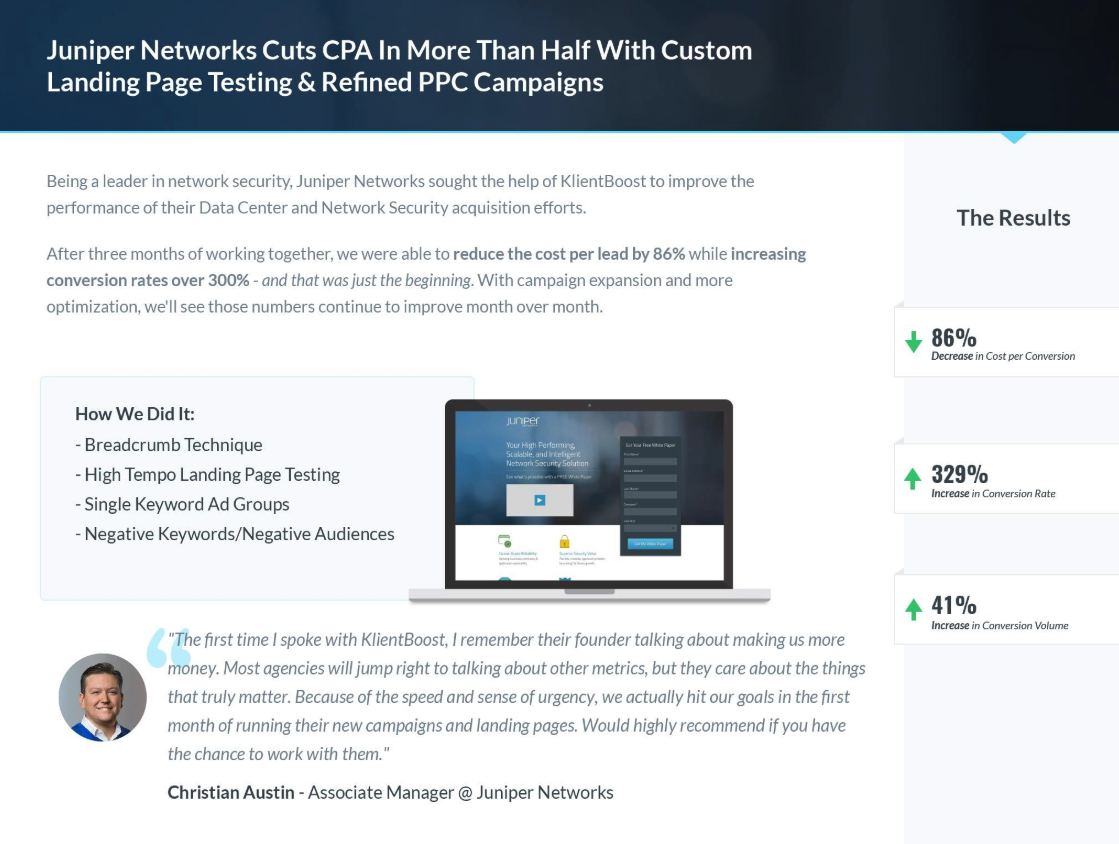There’s a massive ocean of PPC metrics for you to navigate when you enter the online advertising world. One reason pay-per-click (PPC) advertising has exploded as a platform is measurability. The countless different metrics you have at your disposal allow you to track and analyze multiple views of your accounts and campaigns.
The diverse applications of this data are what makes PPC advertising such an intriguing opportunity for so many marketers. Digital marketing offers access to precise sales funnel data that traditional advertising simply can’t provide. Views, clicks, bounces, conversions and more are available to track and improve your campaign.
In short, PPC is driven by data. But some data is more important than others. And once you start A/B testing and optimizing for conversions, separating the useful metrics from the rest becomes even more important.
Get brand new PPC strategies straight to your inbox every week. 23,739 people already are!
Before You Start, Know Your Goals
Real quick: If your company is new to PPC, the metrics below are meant to work in harmony with your business goals. And for that synergy to happen, you have to know which key performance indicators (KPIs) are important to you before you start your campaign.
We can’t stress this enough — the greatest PPC agency on the planet will struggle to produce the results you want if your goals aren’t aligned. So make sure you have a clear understanding of what you need, and what your agency is expected to deliver, before diving into the deep end of PPC.
What Makes A PPC Metric Valuable?
Let’s not overthink this. Valuable PPC metrics are the ones that directly reflect when you make your company money.

The PPC game (at least for us) is about producing tangible results for clients. Chasing numbers that don’t impact your bottom line isn’t a great way to create value or long-lasting relationships. In fact, it’s a great way to burn up budget while you chase these vanity metrics up blind alleys and down dead ends.
On the other hand, establishing the right KPIs and prioritizing the right metrics to track will help keep you on track in choppy waters.
Below are our five most valuable metrics for determining a PPC campaign’s success. We’ll look at why each of these metrics is valuable before turning our attention to others that are… less so.
8 Valuable PPC Metrics (Metrics That Matter)
Before we ladle out the acronym soup of PPC metrics that matter, it’s worth mentioning again that each of these is directly tied to measurable results. By tracking and analyzing these stats, you can make improvements that will turn a flailing PPC campaign into a flourishing one.
1) ROI/ROAS
The most important Google Ads metric you can track is pretty straightforward: What’s your Return on Investment (ROI)? Are you making more money than you’re putting in?
Seems simple, right? But if your bottom line isn’t at the top of the priority list, your PPC campaign can go off the rails quickly.
There are lots of ways to audit and improve the ROI of an existing campaign, from increasing conversion volume to reducing your cost per acquisition (more on those below). For example, if your ad is already drawing users but not generating sales, your PPC campaign might need a more extensive overhaul.

Similarly, Return on Ad Spend (ROAS) tracks the ratio between spending and revenue for vendors with varying checkout amounts, like ecommerce shops. Increasing your revenue — usually with CRO — will grow your ROAS and ensure that your costs are aligned with your spending.
Where ROAS focuses on the specific ratio of ad spend to revenue, ROI calculates return ratios for your campaigns on a broader scale. ROAS focuses on your actual digital campaigns on the micro level, while ROI focuses on the macro level, taking things like salary, overhead, and other factors into account.
2) Cost Per Acquisition/Sale
Our first metric covers the revenue from your PPC efforts. Cost per Acquisition (“CPA,” but not the accounting kind) is how you follow the funds going into your campaign.
The average cost for clicks and conversions can vary widely by campaign and ad group. Factors include how much you’re investing, your average keyword bid rate, and quality scores.
Knowing what you’re spending on each sale helps you set an appropriate context for your PPC campaign too. Your expectations for your ad spend can vary wildly depending on your target audience and what you’re offering.
For example, if you’re selling novelty T-shirts for $25 and spending $25 per click, your PPC campaign isn’t going to help your business.

If, however, you’re bringing in new clients for car insurance policies that average $10,000 over the lifetime of the policy, $50 per click suddenly doesn’t seem so bad.
All that said, here are a few easy ways to reduce your CPA and bolster your campaign:
3 Ways To Reduce Your Cost Per Acquisition
- Cut the fat. Look at the campaigns and keywords that are hurting your performance, and eliminate any wasted spend.
- Go negative (with keywords). Adding negative keywords your ad groups and campaigns refine their relevance, which can reduce your CPA and help the Google Ads system present more appropriate results.
- Lower your max bid. File under ‘obvious,’ but spending less technically does reduce costs, right?
ROI and CPA will never not be the most valuable metrics in your PPC campaign, because they are directly related to your revenue and budget respectively. There are a few more metrics that will have a significant impact on your PPC efforts, however, starting with conversion volume.
3) Conversion Volume
Conversion volume, or the number of users who convert during a certain period, tracks the health of your campaign — a lack of growth here means your campaign needs some serious adjusting.
Even a modest increase in conversion volume can have a major impact on the campaign’s results. (Especially when you use landing page tests and other CRO tactics to improve other areas too.) Increasing conversion volume is the easiest way to grow the ROI/ROAS of your campaigns.
If you can grow your conversion volume while maintaining (or better yet, decreasing) your CPA, you can start generating more revenue from less spend — which is every marketer's dream.

As Optimize Smart says, conversion volume is an accurate reflection of a campaign’s statistical significance and effective reach, and is more ‘optimizable’ than conversion rates. You can start by examining and expanding your keyword pool, for one suggestion.
4) Close Rates
Remember when you were in junior high and there was a crucial, agonizing difference between someone who liked you and someone who liked you liked you?
Google Ads conversions are like that sometimes. Not every conversion is a conversion conversion.
Lots of conversions are just opportunities, not customers. Which is why if you’re truly into results, you need to factor your effective Close Rate into your Cost Per Sale.
Close Rate goes beyond lead conversion rate by reintroducing completed transactions into the mix. This can help with identifying other breakdowns in your system too. If your close rate is a lot lower than your conversion rate, for example, there may be an opportunity to improve lead scoring or the internal transition from acquisition to sales.
5) Cost Per Click
Like conversion volume, Cost Per Click (CPC) is a useful metric for determining your campaign’s overall health. Decreasing CPC can increase your number of total clicks, creating opportunities to grow your total conversions and pump up your ROI.

The most effective way to control what you spend on various keywords is to manage your bids at the keyword level. Keywords that promote more valuable products, for example, might be worth a higher bid than keywords for less worthy conversions.
This goes not only for our SKAGs technique, but can also be expanded to Single Product Ad Groups as well, if you’re in the eCommerce game.
With this strategy, even if you don’t decrease your CPC, your spend will be more effective.
6) Average Order Value
Average Order Value (AOV) is similar to Cost Per Sale. It’s the typical dollar amount customers spend on a complete conversion action.
For example, if your novelty T-shirt shop makes $5,000 in March and closed 50 transactions, your AOV would be $100.

Monitoring your AOV week-to-week or month-to-month provides insight into your customers’ purchasing habits. Because your AOV is directly tied to revenue, it’s another useful benchmark for evaluating your campaign’s performance.
Increasing AOV is also a more effective strategy than increasing traffic (more on that later) because you’re boosting revenue and profit from customers already buying from your store. Further, you can optimize your AOV across all steps of the sales funnel, whereas traffic is strictly a top-of-funnel metric.
7) Lifetime Value
Lifetime value (LTV) is a prediction of the net profit associated with a single customer the duration of your relationship. In other words, how much one buyer spends with you before leaving and never coming back.
Tracking and building strategies around LTV repositions your relationship with your customers as a long-term strategy. Not only is this a sound investment, it can also drastically improve your likelihood of completing future sales.
If you’re committed to prioritizing repeat business, the importance of LTV can’t be overstated — not only is it a Metric that Matters, it might be the only metric that matters. We’re not ready to go that far, but don’t sleep on Lifetime Value as an important indicator for your PPC efforts.
8) Quality Score
Quality Score is less crucial than the metrics above, in that improvements don’t have a one-to-one correlation with a better return. If you can improve your Quality Scores, however, you can save money and energize your campaign’s performance.

The algorithm behind Quality Scores is something of a black box, but it generally depends on three factors:
- Ad relevance
- Quality of landing page
- Possible click-through rate (CTR)
Each factor can be analyzed and improved by your PPC partner, especially if they’re directly involved in landing page design. Tools like dynamic text replacement and tactics like geographic specificity can also help with increasing Quality Score.
The better Quality Score your ads and landing pages manage to generate, the more Google will reward you.
This reward comes in the form of lower CPC and better ad placements on the search engine, both of which should lead to higher click-through-rates and more quality traffic flowing through your ads to your pages. Now it’s just a matter of whether or not you can convert them.
What Makes A PPC Metric “Vain”?
Vanity PPC metrics might look good in a report or a presentation, but they don’t actually provide tangible results for your business. In other words, these metrics are all style, no substance.

Generally, there’s no “good” threshold to reach with these numbers. You’re better off devoting your time to the metrics above, which actually matter in a dollars-and-cents sense. That said, there are still some takeaways and improvements available.
4 Types of PPC Vanity Metrics
Grab your mascara and shake that hairspray can — it’s time for a deep dive into some shallow numbers.
1) Impression-Based Metrics
Tracking your total traffic or impressions can be handy if your PPC campaign’s objective is to get brand exposure and maximize reach.
When it comes to bottom-line results, however, impressions alone won’t do much for you. All you’re seeing is the number of times your ad has appeared to people searching for the target keywords in your campaign. Impressions, traffic, views, whatever you want to call them — this metric doesn’t signify conversions, much less sales.

Obviously, traffic is necessary, as you need people to visit your landing page to convert. And while increasing impressions might create more leads, traffic alone doesn’t make you money.
In fact, as mentioned earlier with the “budget burning,” this type of vague increase in traffic often costs you money in the PPC world. When you’re literally paying for the traffic that your ads are generating click by click, you need to make sure that those clicks are translating into sales.
If you’re chasing vanity metrics like traffic, you may think that your campaigns are succeeding when traffic spikes. But you’re going to be pretty bummed out later on when you see that all you managed to do was increase your ad spend without generating any new revenue...
Before you and your PPC agency put valuable time and resources into boosting your traffic, use the metrics above to create value and convert more of your existing visitors.
Impression-Based Metrics include:
- Cost Per Thousand Impressions (CPM)
- Impression Share
- Traffic
- Clicks
- Click Share
- Visits
- Device Segmentation
- Average Position
- Overlap Rate
- Position Above Rate
- Top Of Page Rate
- Outranking Share
2) Engagement-Based Metrics
One quick caveat — like traffic, engagement is important. If no one is clicking on your ad to get to your website or landing page, your PPC campaign probably needs some TLC, if it isn’t already DOA. (Too many acronyms, sorry!)
Also like traffic, however, engagement-based metrics like click-through rate (CTR) aren’t worth anything if you don’t convert them. If you take a broad, holistic view of your PPC efforts, CTR is just another incidental metric. Instead of sweating over Google Analytics’ CTR data, AdEspresso suggests looking to the “Biggest Changes” report in your dashboard overview to sort your metrics in a more conversion-focused light.
Further, judging the relative CTR to other ads of the same type is a more results-oriented way to track ad performance. Relative CTR is more useful for understanding your campaign’s challenges than overall clicks.
Finally, Quality Scores might also have a negative impact on your CTR — but since we already talked about that, we know you’re on top of it. (And if you’re not, scroll back up and read the ‘Quality Score’ section again so you will be on top of it.)
Here’s a little insider tip: Improving our CTR and Quality Score is at the heart of our SKAGs technique;)
Engagement-Based Metrics include:
- Click-Through Rate
- Cost Per Engagement
- Micro-Conversion Events (“Add to Cart”, “Added Payment Info”, etc.)
- Form Completions
- # of Trial Users
- Email Subscriptions
- Social Media Followers
- Comments
- Page Likes
- Photo Views
- Post Likes
- Post Shares
- % of Video Viewed
3) Behavior-Based Metrics
Just because a metric is easy to access and track in Google Analytics doesn’t mean it’s valuable.
Time on site is a great example. Users can spend lots of time on your landing page, but if they don’t convert, the visit was just as ineffective as someone who bounced immediately — maybe more so.

And this principle also applies to other peripheral on-site metrics like pageviews, pages per visit, and anything else that doesn’t directly correlate to conversions and sales.
In fact, web marketing guru Neil Patel calls the Visitors Overview report that Google Analytics shows at login a “data puke of vanity metrics.” Instead, you’re better off customizing a report view that tracks your business outcomes in relation to your goals. (Sound familiar?)
Patel also points out that using vanity numbers to evaluate your efforts means you’re relying on data that has no relation to your campaign’s performance. If you’re an in-house PPC’er or an agency, this isn’t a recipe for long-term success.
Behavior-Based Metrics include:
- Visitors
- New Users
- Page Views
- Pages Per Visit
- Bounce Rate
- % New Sessions
- Time on Site
4) Relative Campaign Metrics
Reporting in Google Ads lets you look deeply into your campaign’s details, which can lead to useful insights and analysis as your PPC experiment progresses. At this stage, it’s important to avoid the distractions of internal or relative campaign metrics like, for example, your total number of negative keywords.
“Hold on,” we hear you saying. “I thought you said that adding negative keywords was a good thing?”
We did, and it is. (And thanks for paying attention!) But negative keywords are a tool for improving the metrics that matter, not something you need to track in and of itself. Basically, their total number is not important in the grand scheme of your PPC campaign as long as they’re effective.
The same goes for internal metrics like “budget per ad” and “competitive benchmarks” — these numbers shift your focus from your campaign’s results to the campaign itself, and if that’s not vanity, we don’t know what is.
Relative Campaign Metrics include:
- # of Negative Keywords
- Competitive Benchmarks
- Budget Per Ad
- Wasted Ad Spend
- Landing Page SEO Score
- Consistency of Ads Published
Conclusion: Track The PPC Metrics That Lead Toward Success
In the end, tracking PPC metrics comes back to one simple truth: the reason you’re putting money into Google Ads is to get more money in return. Your preferred metrics should indicate real value and results, not “vain” information that doesn’t boost your business.
With that in mind, choosing the right metrics to focus on for your business should be easy — no matter what fancy charts and graphs Google Analytics puts in front of you.